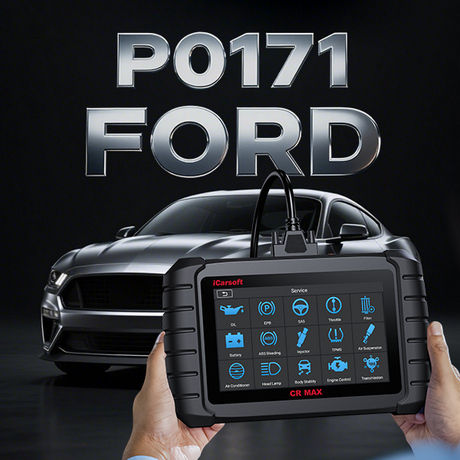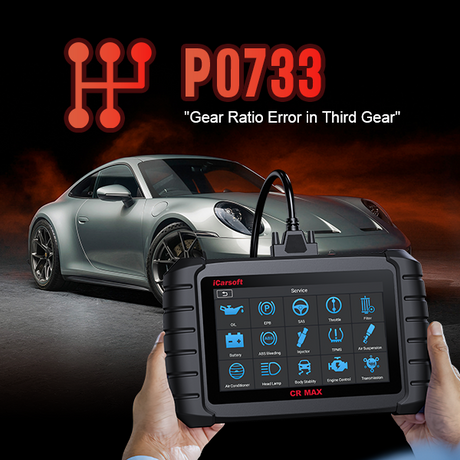In this blog, we’ll dive into the causes, symptoms, and solutions for the P015B code, and show how the iCarsoft CR MAX Vehicle Diagnostic Tool from www.icarsoft-us.com can assist in diagnosing and fixing this issue efficiently.
1. P015B Explained
The P015B code is a diagnostic trouble code (DTC) indicating "O2 Sensor Delayed Response - Lean to Rich (Bank 1, Sensor 1)." This means the oxygen sensor before the catalytic converter on Bank 1 (the engine side with cylinder 1) is slow to respond when the air-fuel mixture shifts from lean (low fuel) to rich (high fuel). The ECU relies on this sensor to adjust the mixture quickly. A delayed response disrupts this process, affecting performance and emissions.

2. What Causes P015B?
Faulty Oxygen Sensor
A worn or contaminated O2 sensor may respond sluggishly due to age or damage.
Exhaust Leaks
Leaks near the sensor can introduce extra oxygen, slowing its response time.
Fuel System Issues
A clogged injector or weak fuel pump can delay the lean-to-rich transition.
Wiring Problems
Damaged or corroded wiring can impair sensor signal transmission to the ECU.
3. Why P015B Occurs
Sensor Contamination
Oil, coolant, or silicone in the exhaust can coat the sensor, reducing its responsiveness.
Engine Wear
Aging engine components may alter exhaust flow, indirectly affecting sensor performance.
4. Vehicles Affected by P015B
The P015B code can appear in OBD-II vehicles, especially those from Ford, Chevrolet, Toyota, Honda, and Nissan. European brands like BMW, Audi, and Volkswagen may also encounter it, particularly in models with high mileage or complex exhaust systems.

5. How Serious Is P015B?
The P015B code is moderately severe. A slow sensor response can lead to poor fuel efficiency, increased emissions, and suboptimal engine performance. Prolonged issues may strain the catalytic converter over time.
6. Safe to Drive with P015B?
Driving with P015B is usually safe short-term, but not recommended long-term. You may experience reduced fuel economy or rough idling, and it could lead to emissions test failures or further engine wear.
7. DIY Fixes for P015B
Sensor Replacement
Replace the sluggish O2 sensor with a high-quality unit, per your vehicle’s manual.
Exhaust Repair
Fix any leaks near the sensor to ensure accurate readings.
Fuel System Check
Clean or replace clogged injectors and test the fuel pump pressure.

8. Diagnosing P015B
Scan Tool
Use the iCarsoft CR MAX to read P015B and monitor live O2 sensor response time (should switch within milliseconds).
Visual Inspection
Check the sensor and exhaust for leaks or contamination.
Fuel Trim Analysis
Examine fuel trim data to identify lean or rich biases affecting sensor performance.
9. Cost to Repair P015B
Costs vary by fix. An O2 sensor replacement ranges from $50-$200, with labor at $50-$150 (1-2 hours at $75/hour), totaling $100-$350. Exhaust repairs cost $100-$500, while fuel system fixes (e.g., injectors) may run $200-$600.
 Learn More about Scan Tool
Learn More about Scan Tool
10. How to Clear P015B
Using a Scan Tool
Connect the iCarsoft CR MAX to clear the code and confirm the repair.
Battery Disconnection
Disconnect the battery for 5-10 minutes to reset the ECU, though this won’t fix underlying issues.

11. Preventing P015B
Routine Maintenance
Keep up with fuel system and exhaust checks to maintain sensor performance.
Quality Fuel
Use clean fuel to avoid contamination.
Sensor Care
Avoid harsh chemicals during repairs that could damage the sensor.
12. Additional P015B Insights
Related Codes
P015B may appear with P015A (rich to lean delay) or P0171 (lean condition). Diagnose together.
Driving Conditions
Frequent short trips may accelerate sensor wear due to incomplete warm-up cycles.
13. Tools for P015B Diagnostics
The iCarsoft CR MAX from www.icarsoft-us.com excels at handling P015B. It reads the code, tracks sensor response in real-time, and helps pinpoint issues. Post-repair, it clears the code and verifies the fix.
Ready to tackle P015B? The iCarsoft CR MAX ensures fast, accurate diagnostics.
Learn More about CR MAX












